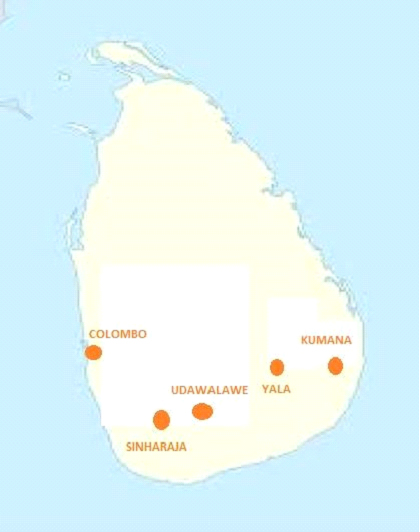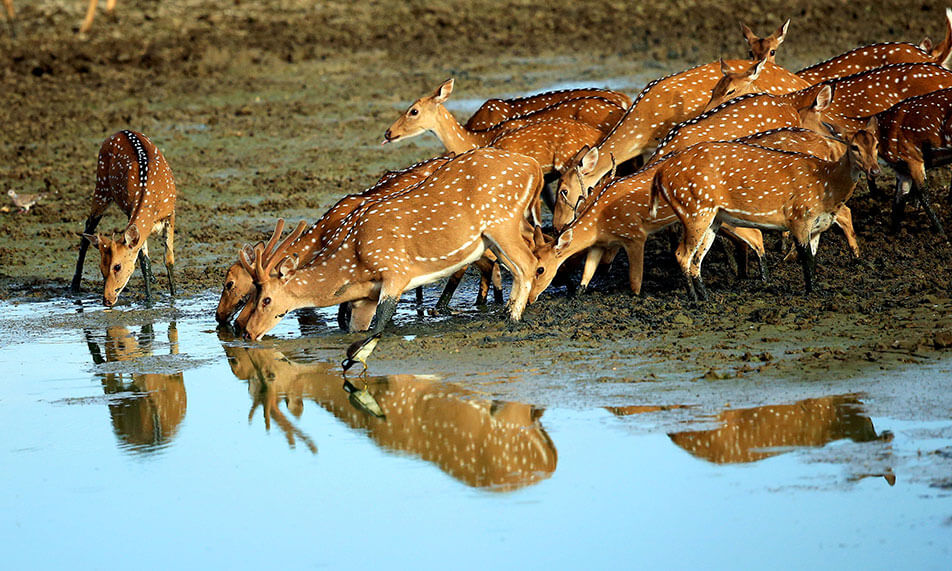Wild Life Tour
Program
2 Nights in Sinharaja1 Night in Udawalawe.
1 Night in Yala.
1 Night in Kumana
1 Night in Colombo
Day 1: Colombo - Sinharaja
Sinharaja Forest Reserve is anational parkand abiodiversity hotspotinSri Lanka. It is of international significance and has been designated aBiosphere ReserveandWorld Heritage SitebyUNESCO.The hilly virgin rainforest, part of theSri Lanka lowland rain forestsecoregion, was saved from the worst of commercial logging by its inaccessibility, and was designated a World Biosphere Reserve in 1978 and a World Heritage Site in 1988. The reserve's name translates as Kingdom of the Lion.
The reserve is only 21 km (13 mi) from east to west, and a maximum of 7 km (4.3 mi) from north to south, but it is a treasure trove ofendemic species, including trees, insects,amphibians, reptiles, birds and mammals.
Because of the dense vegetation, wildlife is not as easily seen as at dry-zone national parks such asYala. There are about 3elephantsand the 15 or soleopardsare rarely seen. The most common larger mammal is the endemicPurple-faced Langur.
Overnight stay in Sinharaja
Day 2: Sinharaja Experience
ACTIVITIES : Trekking, Bird Watching, Camping, Nature Walk, HikingAn interesting phenomenon is that birds tend to move in mixed feeding flocks, invariably led by the fearless Greater Racket-tailed Drongo and the noisy Orange-billed Babbler. Of Sri Lanka's 26 endemic birds, the 20 rainforest species all occur here, including the elusive Red-faced Malkoha, Green-billed Coucal and Sri Lanka Blue Magpie.
Reptiles include the endemic Green pit viper and Hump-nosed vipers, and there are a large variety of amphibians, especially tree frogs. Invertebrates include the endemic Common Birdwing butterfly and the inevitable leeches.
Overnight stay in Sinharaja:
Day 3: Sinharaja – Udawalawe
The Udawalawe National Park website belongs to the Info Sri Lanka group of websites and it aims not only to assist the healthy development of the fauna and flora of the Udawalawe Wildlife Sanctuary and National Park but also to benefit the lives of the people living in the surrounding areas.Along with this the website also targets to encourage these people to protect the Udawalawe National Park and treat it as their own and thereby turning the park into a more prestigious national treasure of Sri Lanka.
In addition to this the website turns the eyes of the whole world to the tourist attractions and tourists destinations found nearby the Udawalawe National Park.
By increasing the opportunities for the visitors to enjoy these attractions the Udawalawe Park website seeks furthermore to bring the attractiveness and popularity of these places as well as the Park to a whole new level.
Each and every tourist will receive a highly efficient and productive service via this site and it is certain that they will be extremely satisfied.
Overnight stay in Udawalawe
Day 4: Udawalawe – Yala
Yala National Park is the most visited and second largestnational parkinSri Lanka. The park consists of five blocks, two of which are now open to the public, and also adjoining parks.The blocks have individual names such as, Ruhuna National Park (block 1) andKumana National Parkor 'Yala East' for the adjoining area. It is situated in the southeast region of the country, and lies inSouthern ProvinceandUva Province.
The park covers 979 square kilometres (378 sq mi) and is located about 300 kilometres (190 mi) fromColombo.Yala was designated as awildlife sanctuaryin 1900, and, along withWilpattuwas one of the first two national parks in Sri Lanka, having been designated in 1938.
The park is best known for its variety of wild animals. It is important for the conservation ofSri Lankan Elephants,Sri Lankan leopardsand aquatic birds.
The area around Yala has hosted several ancient civilisations. Two important pilgrim sites, Sithulpahuwa and MagulVihara, are situated within the park.
The2004 Indian Ocean tsunamicaused severe damage on the Yala National Park and 250 people died in its vicinity. The number of visitors has been on the rise since 2009 after the security situation in the park improved.
Overnight stay in Yala
Day 5: Yala – Kumana
Kumana National Park inSri Lankais renowned for itsavifauna, particularly its large flocks of migratorywaterfowlandwading birds. The park is 391 kilometers (243 mi) southeast ofColomboon Sri Lanka's southeastern coast.Kumana is contiguous withYala National Park.Kumana was formerly known as Yala East National Park, but changed to its present name in 5 September 2006.
The park was closed from 1985 to March 2003 because of the LTTE (Liberation Tigers of Tamil Elam) attacks. It was also affected by theBoxing Day tsunamiin 2004
The Kumana area is part of an ancient civilization that goes back to the 3rd century BC.Rock inscriptionsbelonging to the 2nd and 1st centuries BC have also been found in the region.
The Kumana National Park lies on the route of the traditional annual footPilgrimageto the Hindu temple atKataragama. BothTamilandSinhalesecommunities take part in this pilgrimage.
Overnight :Mahoora Tented Safari Camp







